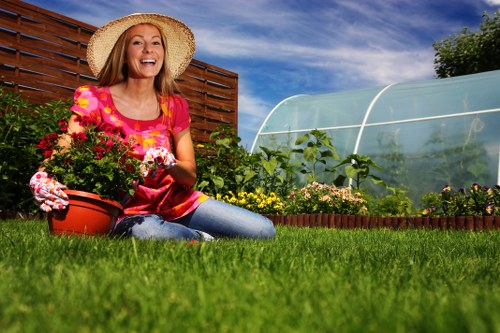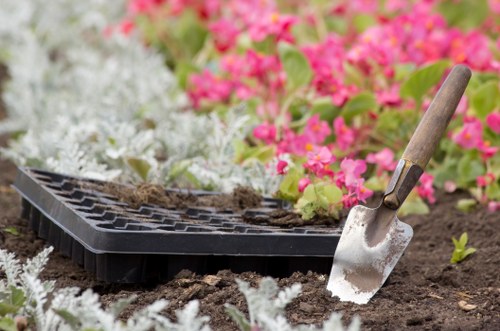Garden Maintenance in St Johns Wood: Keeping Your Green Space Pristine

Maintaining a beautiful garden in St Johns Wood requires dedication, expertise, and the right approach. Whether you're a seasoned gardener or a beginner, understanding the specific needs of your garden can make all the difference. This article delves into the essential aspects of garden maintenance in St Johns Wood, offering practical tips and professional advice to help you create and sustain a stunning outdoor space.
St Johns Wood's unique climate and soil conditions demand tailored gardening strategies. From selecting the right plants to implementing effective maintenance routines, every decision plays a crucial role in the health and beauty of your garden. By following the guidelines outlined here, you'll be well-equipped to tackle the challenges and enjoy a flourishing garden year-round.
Effective garden maintenance not only enhances the aesthetic appeal of your property but also contributes to the overall well-being of your environment. A well-maintained garden can serve as a peaceful retreat, a vibrant social space, and a haven for local wildlife. Let's explore the key elements that contribute to successful garden maintenance in this charming London neighborhood.

Understanding the St Johns Wood Climate
St Johns Wood experiences a temperate maritime climate, characterized by mild winters and cool summers. This climate influences the types of plants that thrive in the area and dictates the maintenance schedules gardeners should follow.
Key Climate Considerations:
- Temperature: Average temperatures range from 2°C in winter to 22°C in summer.
- Precipitation: The area receives moderate rainfall throughout the year, with occasional heavy showers.
- Sunlight: Most gardens in St Johns Wood enjoy a good amount of sunlight, though some areas may be shaded by nearby buildings.
Understanding these climatic factors helps in selecting plants that are well-suited to the environment, ensuring they remain healthy and vibrant.

Choosing the Right Plants for Your Garden
Selecting plants that thrive in St Johns Wood's climate is crucial for minimizing maintenance efforts and maximizing garden beauty.
Perennials vs. Annuals
Perennials are plants that live for more than two years, providing continuous color and structure to your garden. Examples include lavender, hostas, and daylilies. They require less frequent replanting and are generally more robust.
Annuals complete their life cycle in one growing season. They are perfect for adding vibrant colors and filling gaps in your garden design. Common annuals include petunias, marigolds, and geraniums.
Incorporating a mix of perennials and annuals can create a dynamic and resilient garden that stays attractive throughout the year.

Essential Garden Maintenance Tasks
Regular maintenance is key to ensuring your garden remains healthy and attractive. Here are some essential tasks to include in your maintenance routine:
Pruning and Trimming
Pruning helps maintain the shape and size of your plants, encourages healthy growth, and removes any dead or diseased branches. It's essential to prune at the right time of year for each plant species.
Weeding
Weeds compete with your garden plants for nutrients, water, and sunlight. Regular weeding prevents them from taking over your garden beds and ensures your desired plants thrive.
Watering
Proper watering is vital, especially during dry spells. Installing a drip irrigation system can help conserve water and ensure even distribution to all parts of your garden.

Seasonal Gardening Tips
Adapting your garden maintenance practices to the changing seasons can greatly enhance the health and appearance of your garden.
Spring
Spring is the time for planting new flowers, mulching, and preparing the soil. It's also the perfect season to fertilize your plants and address any winter damage.
Summer
During the summer months, focus on regular watering, deadheading spent blooms, and managing pests. Providing adequate shade and ventilation can help protect your plants from excessive heat.
Autumn
Autumn is ideal for planting bulbs for spring, raking leaves, and dividing perennials. It’s also a good time to prepare your garden for the upcoming winter by cleaning up debris and applying a layer of compost.
Winter
Winter maintenance includes pruning dormant plants, protecting sensitive species from frost, and planning for the next growing season. Using frost cloths and mulches can help shield your plants from harsh weather conditions.

Utilizing Professional Garden Maintenance Services
While DIY maintenance can be rewarding, enlisting the help of professional garden maintenance services in St Johns Wood can ensure your garden receives expert care. Professionals bring specialized knowledge, equipment, and experience to handle complex tasks efficiently.
Benefits of Hiring Professionals
- Expertise: Professionals understand the local climate and soil conditions, enabling them to make informed decisions about plant selection and care.
- Time-Saving: Outsourcing maintenance frees up your time, allowing you to enjoy your garden without the stress of upkeep.
- Quality Results: Skilled gardeners ensure that all maintenance tasks are performed to a high standard, enhancing the overall appearance of your garden.
Choosing the Right Service Provider
When selecting a garden maintenance service in St Johns Wood, consider their experience, range of services, and customer reviews. A reliable provider will tailor their services to meet your specific needs and budget.

Eco-Friendly Gardening Practices
Adopting eco-friendly practices in your garden maintenance not only benefits the environment but also promotes a healthier garden ecosystem.
Composting
Composting kitchen scraps and garden waste enriches the soil with nutrients, reducing the need for chemical fertilizers. It also helps in managing waste sustainably.
Water Conservation
Implementing rainwater harvesting and using drought-resistant plants can significantly reduce water usage, making your garden more sustainable.
Natural Pest Control
Using natural predators, organic sprays, and companion planting can effectively manage pests without harming beneficial insects or the environment.

Designing Your Garden Layout
A well-thought-out garden layout enhances both functionality and aesthetics. Consider factors like plant height, color schemes, and seasonal interest when planning your garden design.
Plant Arrangement
Arrange plants based on their size, ensuring taller plants do not overshadow smaller ones. Grouping plants with similar water and sunlight needs can also streamline maintenance efforts.
Pathways and Seating Areas
Incorporate pathways and seating areas to create accessible and inviting spaces. Materials like gravel, stone, or wood can add texture and visual interest to your garden.
Focal Points
Introduce focal points such as sculptures, water features, or unique plant specimens to draw attention and add character to your garden.

Lighting Your Garden
Outdoor lighting enhances your garden's beauty and functionality, allowing you to enjoy it even after dark.
Types of Garden Lighting
- Path Lights: Illuminate walkways and prevent accidents.
- Spotlights: Highlight specific garden features like trees or sculptures.
- Ambient Lighting: Create a warm and inviting atmosphere with soft, general illumination.
Energy-Efficient Options
Consider using LED lights or solar-powered fixtures to reduce energy consumption and minimize your environmental impact.

Maintaining Garden Tools and Equipment
Proper maintenance of garden tools and equipment ensures their longevity and effectiveness, making your gardening tasks easier and more efficient.
Cleaning and Storage
After each use, clean your tools to remove dirt and debris. Store them in a dry, sheltered area to prevent rust and damage.
Regular Sharpening
Keep blades sharp by regularly sharpening pruners, shears, and other cutting tools. Sharp tools make cleaner cuts, promoting healthier plant growth.
Equipment Inspections
Periodically inspect your equipment for signs of wear and tear. Replace or repair any damaged parts to maintain optimal performance.

Addressing Common Garden Problems
Even with diligent maintenance, gardens can face various challenges. Being proactive in identifying and addressing these issues ensures your garden remains healthy and vibrant.
Pest Infestations
Common pests in St Johns Wood gardens include aphids, slugs, and snails. Implementing natural pest control methods can help manage these issues effectively.
Disease Management
Fungal diseases like powdery mildew and rust can affect garden plants. Regular monitoring and appropriate treatment can prevent the spread of these diseases.
Soil Health
Maintaining healthy soil is fundamental to plant health. Regularly testing soil pH and nutrient levels, along with adding organic matter, can enhance soil fertility.

Incorporating Sustainable Practices
Sustainability in garden maintenance not only preserves the environment but also creates a self-sufficient and resilient garden ecosystem.
Native Plants
Choosing native plants that are well-adapted to the local climate reduces the need for excessive watering and chemical inputs, promoting a sustainable garden.
Mulching
Applying mulch helps retain soil moisture, suppress weeds, and improve soil structure, contributing to a more sustainable garden environment.
Green Manure
Using green manure crops like clover and rye can enrich the soil with organic matter and essential nutrients, enhancing soil health naturally.

Enhancing Garden Aesthetics
Creating an aesthetically pleasing garden involves thoughtful design and attention to detail. Here are some tips to enhance the visual appeal of your garden:
Color Coordination
Choose a harmonious color palette for your plants to create a cohesive and attractive garden space. Complementary colors can add vibrancy, while analogous colors provide a serene ambiance.
Texture and Structure
Incorporate a variety of plant textures and structures to add depth and interest. Mix flowering plants with foliage plants to create a dynamic landscape.
Garden Features
Integrate features like trellises, arches, and pergolas to add architectural interest and provide support for climbing plants.

Maintaining Privacy and Security
A well-maintained garden can provide privacy and enhance the security of your property. Here are some strategies to achieve this:
Hedges and Screening Plants
Planting dense hedges or screening plants like boxwood and privet creates natural barriers, ensuring privacy from neighbors and passersby.
Fencing and Gates
Installing sturdy fences and gates not only defines your garden boundaries but also deters unwanted visitors.
Lighting and Surveillance
Strategic outdoor lighting and security cameras can enhance the safety of your garden, providing peace of mind.

Maximizing Garden Space
Optimizing your garden space ensures that every inch is utilized effectively, enhancing both functionality and beauty.
Vertical Gardening
Using vertical spaces for planting can save ground space and create stunning visual displays. Options include wall-mounted planters, trellises, and green walls.
Container Gardening
Container gardening offers flexibility and allows you to move plants as needed. It’s ideal for small spaces and can add a pop of color to patios and balconies.
Multi-Functional Areas
Create areas that serve multiple purposes, such as combining seating with plant beds or integrating play areas for children with decorative elements.

Final Thoughts on Garden Maintenance in St Johns Wood
Maintaining a garden in St Johns Wood is a rewarding endeavor that enhances your living space and contributes to the community's natural beauty. By understanding the local climate, selecting appropriate plants, and adhering to regular maintenance practices, you can cultivate a thriving garden that brings joy and tranquility throughout the year.
Whether you choose to undertake maintenance tasks yourself or hire professional services, the key to a beautiful garden lies in consistent care and thoughtful planning. Embrace sustainable practices, stay informed about gardening trends, and continuously seek ways to improve your garden’s health and appearance.
Ready to transform your garden into a stunning oasis? Contact us today to schedule your professional garden maintenance service in St Johns Wood and take the first step towards a more beautiful and vibrant outdoor space.

Frequently Asked Questions
How often should I water my garden in St Johns Wood?
Watering frequency depends on the plant types and current weather conditions. Generally, gardens in St Johns Wood benefit from deep watering once or twice a week during dry spells.
What are the best plants for low-maintenance gardens?
Perennials like lavender, hostas, and sedum are excellent choices for low-maintenance gardens. These plants require minimal care once established and are resilient to local conditions.
Can I maintain my garden on my own, or should I hire a professional?
While many gardeners enjoy the DIY approach, hiring a professional ensures expert care and can save you time. Consider your gardening experience, time availability, and the complexity of your garden when making this decision.

Stay Connected
For ongoing tips, updates, and professional advice on garden maintenance in St Johns Wood, subscribe to our newsletter and follow us on social media. Stay informed about the latest gardening trends and ensure your garden remains a beautiful and thriving space all year round.
Your garden's health and beauty are just a step away!
Book your service now and experience the difference professional garden maintenance can make.

